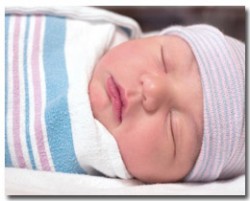
SIDS & Safe Sleep Practices
After putting my youngest, still a baby, to bed last night, I read an article about a baby who died after going into heart failure. The baby (6 weeks old) was thought to have been sleeping in her parents’ bed and accidentally suffocated. Suffocation due to avoidable circumstances and factors, does not fall under the SIDS definition, so herein, SIDS only refers to unexplainable deaths in infants.
However, it did get me to thinking (for the thousandth time) about SIDS. We don’t know what causes SIDS, so we cannot say how to absolutely “avoid” it, but below are the most up-to-the-minute guidelines for reducing the risk of SIDS and other sudden unexplained infant deaths (SUID). First and foremost, educate yourself and everyone who cares for your baby on how to reduce the risks by following these guidelines, adapted from those provided by The CJ Foundation for SIDS:
1. Always lay your baby to sleep face up.
Side and tummy positions are not safe; check with your doctor if your baby has breathing problems.
2. Don’t smoke while pregnant and never smoke near your infant.
While pregnant or considering pregnancy do not smoke. Never let others smoke near your baby. Smoking is a major risk factor for SIDS.
3. Don’t let your baby get too hot.
Overheating is a leading risk factor for SIDS. Dress your baby in as much or as little as you would wear. If your baby is sweating, has damp hair, or a heat rash, he or she may be too hot. Room fans have been shown to reduce the risk of SIDS. Consider using a wearable blanket or other type of sleeper instead of a blanket. 22 degrees is about right for a bedroom.
4. Lay your baby to sleep in an approved crib, on a firm mattress.
Do not let the baby sleep on soft things, like a couch, pillow, sheepskin, foam pad, or waterbed. Remove all loose bedding, stuffed animals, and pillows from crib. Crib bumpers are not recommended and can be hazardous. Nothing needs to be in a baby’s bed but the baby.
5. Create a healthy lifestyle for you and your baby.
When pregnant, see your doctor often and do not use drugs or alcohol. Talk with your doctor about changes in your baby and how your baby acts.
6. If possible, breast feed your baby.
Breast feeding has been shown to reduce the risk of SIDS.
7. Offer your newborn baby a pacifier (up to around three months of age) at sleep times.
Pacifiers have been shown to reduce the risk of SIDS. It’s wise to cease letting them suck to sleep after 3 months, so it doesn’t become a crutch that prevents them from learning healthy sleep and self settling skills.
8. Put your baby on his or her tummy to play when your baby is awake and supervised.
Make sure someone is always watching. “Tummy Time” is good for your baby because it makes neck and shoulder muscles stronger.
9. Don’t share sleep surfaces.
This is a personal choice, but I always recommend a side sleeper/bassinet close enough for you to touch your newborn. Adult beds, couches, and chairs are not safe for infant sleep and increase the risk of SIDS, suffocation and accidental infant death. After breast feeding/feeding put your baby back in his or her bed.
10. Share these tips with everyone who cares for your baby.
Educating yourself and others who care for your baby can help you keep your baby safe.
Live Well


